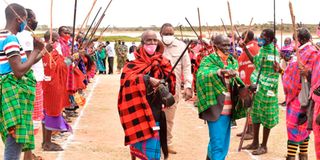It’s time we protected children against violation of their rights

President Uhuru Kenyatta joins Samburu elders during a blessing ceremony for girls who have not undergone female genital cutting to be accepted by society. Kenya aims to eradicate the ‘cut’ by next year.
What you need to know:
- As in every other year, NGOs, governments and other interest groups will unite to discuss obstacles to the full rights of the African child.
- African governments should fully address obstacles in safeguarding the children — especially the girl — who is confronted by unique challenges.
Today is that special day of the year when Africa pauses to celebrate its children and take account of the progress made on their welfare and rights.
The Day of the African Child (DAC), observed every June 16, was initiated 30 years ago by the Organisation of African Unity, the precursor to the African Union, to commemorate black South African students massacred in Soweto in a street protest in 1976. They were protesting poor standards of education under the Apartheid regime and demanding the right to be taught in their native languages.
To commemorate the courageous children and their brave action, which saw hundreds of protesters killed and thousands more injured in the two-week Soweto Uprising, the OAU Heads of State and Government originated the Day of the African Child in 1991.
AU, through the African Committee of Experts on the Rights and Welfare of the Child, and guided by the African Charter on the Rights and Welfare of the Child (the Charter), has always used the day to promote and campaign for the human rights, well-being and prosperity of children and “inspire a sober reflection and action towards addressing the plethora of challenges that children in Africa face on a daily basis”.
But the committee can only do so much. Member states are obliged to ensure their children enjoy full rights and protection. This is the moral and right thing to do and governments that default on it are bound to fail.
Fully address obstacles
As in every other year, non-governmental organisations, especially those in the children’s and human rights segment, governments and other interest groups will unite to discuss obstacles to the full rights of the African child. It will also be an opportunity to consider progress in realisation of all these rights and suggest solutions where things appear to slow down or stagnate.
African governments should fully address obstacles in safeguarding the children — especially the girl — who is confronted by unique challenges. And nations must embrace DAC as a solemn day of reflection, examination and serious self-analysis of their commitment to deal with what is usually packaged as insurmountable difficulties to the comprehensive advancement and protection of children’s rights. It’s critical to ensure that these rights, including access to proper health and nutrition, are enjoyed.
In Kenya, protecting the child against all forms of violations — such as gender-based violence, abuse, neglect and exploitation — appears to be an uphill task for the authorities if media reports are anything to go by, with widespread brutality against girls, especially.
Examples of defilement by people who should be taking care of the minors in environments like school and home are legion. The stories of incest that emanated from Busia County and reported widely this month were shocking. Sadly, the reports are a fraction of this horrible crime that occurs behind dark family walls with girls the main victims.
Abuse of girls’ rights
Female genital cutting — that terrible abuse of girls’ rights — is a dominant problem in the country as it paves the way for bigger and wider violations of their human rights. This includes dropping out of school, child marriage and teenage pregnancy.
Interest groups, mainly in the human rights of girls and women sector, should work together against the practice.
At a recent forum on the female ‘cut’ by Voice for Women and Girls Rights (VWGRs) -- a Journalists for Human Rights Kenya project -- which brought together media and civil society organisations, the role of the media was identified as key in shifting or propagating attitudes towards abuse and violations against girls and women.
This solution-based focus such as that adopted by the organisation is critical in bringing to the fore the main violator of girls rights that is the ‘cut’. This concerted effort, which includes grassroots campaigners, will, hopefully, accelerate the progress towards Kenya’s target to end female circumcision by next year, much ahead of the 2030 global deadline.
Ms Rugene is a consulting editor and founder, The Woman’s Newsroom Foundation. [email protected] @nrugene





